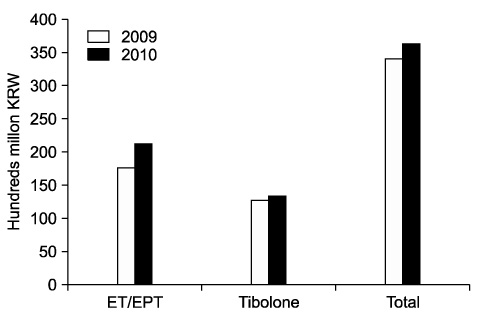J Korean Soc Menopause.
2011 Dec;17(3):150-154. 10.6118/jksm.2011.17.3.150.
The National Use of Hormonal Therapy in Postmenopausal Women in 2010
- Affiliations
-
- 1Department of Obstetrics and Gynecology, Chonnam National University Medical School, Gwangju, Seoul, Korea.
- 2Department of Obstetrics and Gynecology, College of Medicine, Chung-Ang University, Seoul, Korea. hmpark@hananet.net
- KMID: 1444803
- DOI: http://doi.org/10.6118/jksm.2011.17.3.150
Abstract
OBJECTIVES
To analyze the domestic consumption of postmenopausal hormonal medicine in the year 2010 and compare it with those since 2002.
METHODS
Data from Intercontinental Marketing Services were used to analyze the consumption of hormonal medicine in the year 2010. Total hormonal medicines consisted of estrogen (ET), estrogen+progestogen (EPT), and Tibolone. We compared the respective consumption of hormonal medicines in the year 2010 with those since 2002. The percentage and frequency of usage of ET, ET/EPT, and tibolone in the year 2010 were also estimated.
RESULTS
We found that 4.5% of women over 50 years of age had taken the postmenopausal hormonal medicine in the year 2010. The usage rate of each medicine showed 60% for ET/EPT compound, and 40% for Tibolone. The usage of postmenopausal hormonal medicine in 2010 increased by 7% compared to the previous year reaching 3.81 billion Korean won. There was 9% increase in the use of ET/EPT compound, and 4% increase in Tibolone.
CONCLUSION
The total consumption of postmenopausal hormonal medicine was markedly decreased between 2002 and 2007. Since 2007, however, it has been steadily increasing from 3.01 billion to more than 3.81 billion Korea won in 2010, which maybe due to the reappraisal of the WHI study results, the change of doctor's recognition, and the increased consumption of Tibolone. When initiating postmenopausal hormone replacement therapy, the risk-benefit of hormonal therapy should be thoroughly explored.
Keyword
MeSH Terms
Figure
Reference
-
1. Hersh AL, Stefanick ML, Stafford RS. National use of postmenopausal hormone therapy: annual trends and response to recent evidence. JAMA. 2004. 291:47–53.2. Kim JY, Sang JH, Park HM. The change of hormone therapy in postmenopausal women in Korea before and after women's health initiative study: 2000~2009. Korean J Obstet Gynecol. 2010. 53:1110–1117.3. Sturdee DW, Pines A, Archer DF, Baber RJ, Barlow D, Birkhauser MH, et al. Updated IMS recommendations on postmenopausal hormone therapy and preventive strategies for midlife health. Climacteric. 2011. 14:302–320.4. Korea National Statistical Office. Population Projections for Korea: 2005~2050. 2006. Daejeon: Korea National Statistical Office.5. Blumel JE, Chedraui P, Baron G, Belzares E, Bencosme A, Calle A, et al. A large multinational study of vasomotor symptom prevalence, duration, and impact on quality of life in middle-aged women. Menopause. 2011. 18:778–785.6. Sang JH, Park HM. The National use of antiosteoporosis medication in 2009. J Korean Soc Menopause. 2010. 16:170–175.7. Phillips LS, Langer RD. Postmenopausal hormone therapy: critical reappraisal and a unified hypothesis. Fertil Steril. 2005. 83:558–566.8. Birkhauser MH, Reinecke I. Current trends in hormone replacement therapy: perceptions and usage. Climacteric. 2008. 11:192–200.9. Andersson K, Mattsson LA, Milsom I. Use of hormone replacement therapy. Lancet. 1996. 348:1521.10. Huang KE, Baber R. Updated clinical recommendations for the use of tibolone in Asian women. Climacteric. 2010. 13:317–327.
- Full Text Links
- Actions
-
Cited
- CITED
-
- Close
- Share
- Similar articles
-
- The usefulness of laparoscopic myomectomy after Hormone Replacement Therapy in postmenopausal women with uterine myoma
- The effect of adjuvant hormonal therapy on the endometrium and ovary of breast cancer patients
- Long-term Hormonal Replacement Therapy in Postmenopausal Women: In Its Positive aspects
- Long-term Hormonal Replacement Therapy in Postmenopausal Women : In Its Negative Aspects
- Minireview: A Need for an Adequate Diet Program for Postmenopausal Women with Obesity in the Republic of Korea


